Financing is an essential but challenging part of the development process for adaptation plans. Developing a financing strategy for adaptation plans is vital when considering potential financial resources, and this of course depends on the size of the financial needs for each step of the process. This involves blending multiple resources including domestic, international and private finance according to specific budgets for each step of the adaptation plan development process.
Particularly in relation to National Adaptation Plans (NAPs), it should be noted that not all activities indicated are necessarily undertaken in the near-term. This means that any financial strategies for mid- and long-term activities could remain flexible up to the appropriate point. The following figure illustrates the phases and examples of financed activities in the processes of NAP formulation and implementation.
Identify financial strategies for NAP formulation and implementation

Broadly speaking, the required finance can be categorized into two parts: start-up finance and up-scaling finance. Start-up finance is the budget needed at the early stage of the NAP Process, or in the formulating phases including preparatory elements (and the groundwork and addressing gaps, if necessary) and implementation strategies. Start-up finance might encompass vulnerability assessment, stakeholder consultation, and capacity development for planning and implementation. Once the plan is put in place, up-scale finance is required to move on to the implementation phase that includes project implementation followed by reporting, monitoring and review phases. Project implementation usually requires significantly larger budgets especially when it involves construction, operation and maintenance. Subsequently, a country should collect information and assess the results of projects that also require extra budgets. Financial strategies for NAP formulation and implementation could start by estimating budgets for necessary programs or activities in each phase, and then go on to identify potential financial resources.
Following identification of the strategies, countries have to define a portfolio that reflects consideration of their current circumstances and situation to proceed each phase by blending multiple financial resources. In the start-up phase, national or sub-national budgets are commonly mobilized to prepare planning, while international aid also plays a critical role as many developing countries lack domestic budgets. The up-scaling phase requires extended fund-raising including domestic climate funds, multilateral development bank or non-climate targeted multilateral funds. The use of private capital should also be looked into, as public finance alone is unlikely to be enough to meet financial needs in this phase. The following section introduces some features and concrete examples of three types of financial resources. The process of identifying financial strategies can be mostly applied to local adaptation planning, with some additional considerations also necessary.
Blend financial resources for NAP formulation and implementation

- International Funding
-
International finance is provided through either bilateral channels or multilateral channels based on their priority areas. It ranges from grants and technical assistance to advance the development phase of the NAP process, to loans supporting larger scaled projects. Bilateral assistance, including official development assistance (ODA) and other official flows, is extended e on issues of mutual interest to the two concerned countries. Bilateral assistance can be quicker and simpler than multilateral channels. Multilateral assistance takes a relatively longer time as it involves globally competitive processes. On the other hand, there are a number of multiple funds that are specifically designed to address climate change.
It should be noted that the UNFCCC established a series of financial mechanisms to provide financial resources to adaptation planning in developing countries, including Green Climate Funds, Adaptation Fund, Special Climate Change Fund and Least Developing Countries Fund. - Domestic Funding
-
Domestic public finance makes a significant contribution to human and financial resources when coordinating the process of adaptation planning, especially in the very early stages.Most adaptation activities are implemented for the public good, so public spending is also an important resource for implementation. There are several ways to secure finances for the national government including taxes, sovereign bonds, and debts. Furthermore, the government can raise funding through redistribution of budget allocation, such as through subsidy reforms. In the up-scaling phase, domestic climate funds are also available in some countries and these support national adaptation projects.
- Private Capital
-
Private capital is provided by companies and non-state organizations, as well as through philanthropy. Such capital is also a significant financial resource for implementation of the NAP. Arrangements can be made not only by governments but also by enterprises and financiers through investment decisions in line with their business interests. To utilize private sector finance, financial instruments including loans, bonds, debts and insurance can be considered. Nowadays, there are a wide range of financial products that focus on climate change and sustainable development (e.g. green bonds, sustainable bonds) as well as risk management (e.g. catastrophe bonds) that can be utilized for adaptation actions taken by governments and non-state actors.
Reference:
J. Parry, Dazé, A., Dekens, J., Terton, A., Brossmann, M., Oppowa, S. 2017. Financing National Adaptation Plan (NAP) Processes: Contributing to the achievement of nationally determined contribution (NDC) adaptation goals. International Institute for Sustainable Development (IISD).
Least Developed Countries Expert Group. 2012. National Adaptation Plans. Technical guidelines for the national adaptation plan process. Bonn: UNFCCC secretariat. Bonn, Germany. December 2012.

- ADAPTATION PLAN DEVELOPMENT PROCESS
- Whether you’re looking to update an adaptation plan or are intending to start on one, engaging in the adaptation planning process is important work. Once you identify where your country is located in the process, you will find useful information such as tools and good practices.

- NAP PROCESS UNDER THE UN FRAMEWORK
- Understand why adaptation planning is necessary in the long run to implement the Paris Agreement. Learn about the latest trends in international adaptation negotiations and support systems for NAP formulation under the UN bodies.

- STATUS OF ADAPTATION IN THE ASIA-PACIFIC
- What adaptation plans are being developed in the Asia-Pacific? Learn some of the most distinctive features and best practices, and find the latest information on adaptation plans being carried out by your neighboring countries or countries facing similar challenges.

- Monitoring & Evaluation
- Once adaptation measures are implemented, Monitoring and Evaluation (M&E) is conducted to track and evaluate the effectiveness of adaptation measures. Find useful resources including the latest discussions and good practices here.
